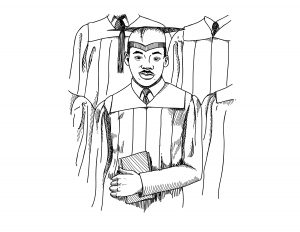Blog
James Alexander Thom: A Shining Light of Letters
 Indiana has lost one of their shining lights of letters. During his long and highly regarded career as a journalist and teacher, James Alexander Thom impacted many people. As an author, he impacted many more. It was perhaps through his prose that most people came to know him. But James was never one of those cloistered writers we often see in the movies. He had a love for getting out there and meeting his readers. So many of us were lucky to get to know James even if just a bit. “I never saw a writer more at home in a crowd as James,” says his publisher of three books, Tom Doherty of Blue River Press.
Indiana has lost one of their shining lights of letters. During his long and highly regarded career as a journalist and teacher, James Alexander Thom impacted many people. As an author, he impacted many more. It was perhaps through his prose that most people came to know him. But James was never one of those cloistered writers we often see in the movies. He had a love for getting out there and meeting his readers. So many of us were lucky to get to know James even if just a bit. “I never saw a writer more at home in a crowd as James,” says his publisher of three books, Tom Doherty of Blue River Press.
James was just friendly that way. He was a man that was as comfortable extoling the virtues of chopping your own wood, as he was in the lecture hall speaking of journalism, literature, and history. James could speak on just about any topic and was always willing to listen as much as he spoke.
 His mastery of the genre of historical fiction is renowned. Blue River Press published his tome on the subject in 2017, Once Upon a Time It Was Now: The Art & Craft of Writing Historical Fiction. That book has inspired thousands of writers and remains the preeminent book on the subject. But perhaps James’ most enduring legacy will be his works of historical fiction.
His mastery of the genre of historical fiction is renowned. Blue River Press published his tome on the subject in 2017, Once Upon a Time It Was Now: The Art & Craft of Writing Historical Fiction. That book has inspired thousands of writers and remains the preeminent book on the subject. But perhaps James’ most enduring legacy will be his works of historical fiction.
James burst on to the NYT bestsellers list with his novel Follow the River, published by Random House in 1981. It wasn’t James’ first novel, but it was the one that gained him a national audience eager for more. And there would be more historical novels that would follow, including his most recent paperback edition of Fire in the Water, published by Blue River Press in 2017.
 James’ long-time collaborator Dark Rain also co-authored the popular Warrior Woman: The Exceptional Life Story of Nonhelema, Shawnee Indian Woman Chief, published by Ballantine Books, a Random House imprint, in 2003. Of which, Publishers Weekly wrote: “In this dense, moving fictional account of 12 critical years in Shawnee history, veteran historical novelist Thom (Sign-Talker, etc.) and his Shawnee wife tell the story of a remarkable woman who led her people’s doomed resistance against her better judgment.”
James’ long-time collaborator Dark Rain also co-authored the popular Warrior Woman: The Exceptional Life Story of Nonhelema, Shawnee Indian Woman Chief, published by Ballantine Books, a Random House imprint, in 2003. Of which, Publishers Weekly wrote: “In this dense, moving fictional account of 12 critical years in Shawnee history, veteran historical novelist Thom (Sign-Talker, etc.) and his Shawnee wife tell the story of a remarkable woman who led her people’s doomed resistance against her better judgment.”
 James and Dark Rain were more than a writing team, they were an inspiration to many who knew the value of sticking together through thick and thin. Longtime business associate and friend, Adriane Doherty, expressed that “no two people were a better expression of the adage that one plus one can add up to more than two.”
James and Dark Rain were more than a writing team, they were an inspiration to many who knew the value of sticking together through thick and thin. Longtime business associate and friend, Adriane Doherty, expressed that “no two people were a better expression of the adage that one plus one can add up to more than two.”

Proud and doomed, Irish rogue cannoneers fighting against their former comrades-in-arms.
We at Blue River Press and Cardinal Publishers Group salute James Alexander Thom on a life well lived and a legacy that will earn him a spot in the pantheon of great Hoosier writers. He was a very lucky man who had an enviable career and an essence of peace always within himself and the family and friends that surrounded him.
He Blazed a Trail for Civil Rights

Born on January 15, 1929 in Atlanta, Georgia, to Martin Luther King and Alberta Williams King, Martin Luther King, Jr. would grow to be one of America’s greatest influencers. Dr. King lived a full and purposed life. Though he faced many challenges, he blazed a trail for civil rights.
As a Young Man
He attended the first African-American public high school in Atlanta, Booker T. Washington High School. As a top student, he was able to skip his freshman and senior years and entered his college education at the tender age of 15. While still in college, he was ordained a Baptist minister then graduated from Moorehead College in 1948, and he continued to preach powerful, inspiring sermons. He desired to follow in his father’s footsteps and become a pastor, so he enrolled in Crozer Theological Seminary.
freshman and senior years and entered his college education at the tender age of 15. While still in college, he was ordained a Baptist minister then graduated from Moorehead College in 1948, and he continued to preach powerful, inspiring sermons. He desired to follow in his father’s footsteps and become a pastor, so he enrolled in Crozer Theological Seminary.
When he met Coretta Scott, he knew right away she was the one for him. They were married and lived in Boston while he finished his Ph.D at Boston University. There he saw black and white people living and working together more freely.
Influenced by Jesus, Gandhi, and Thoreau
As he was greatly motivated by Jesus, he was also influenced by Mohandas Gandhi and Henry David Thoreau. Through Gandhi’s demonstration of peaceful protesting, he saw that it was possible to cause the changes he wanted to see without violence. If people came together, America would change.
 Marches
Marches
He led peaceful protests and marches for racial equality. One of the most noted marches was Selma, Alabama to Montgomery, Alabama. Thousands both black and white traveled to Selma to participate in the march. Tension was high and protesters were attacked by state troopers with tear gas and night sticks, but they marched on. As they proceeded toward Montgomery, they came upon a bridge and faced a wall of state troopers. Dr. King led the way and could clearly see that if they moved forward, they would surely meet with violence and resistance, so he encouraged them to turn back and try again later. In the meantime, the number of participators grew, and President Johnson stepped in to help the march do well. The 54-mile march from Selma to Montgomery took 5 days. With nearly 25,000 marchers, they were able to successfully hand the petition for equal voting rights to Governor George Wallace.
An Appointed Leader
Because of his leadership and encouragement many freedoms were gained for African-Americans. The Civil Rights Movement grew, and people listened to the powerful words of Dr. Martin Luther King, Jr. He and Coretta led marches against poverty, he met with President Kennedy, and he was elected into the fellowship of American Academy of Arts and Sciences. He was a hero and changed the lives of many Americans.
Young Readers
Young readers can learn all about Dr. King in the book All About Martin Luther King, Jr. by Todd Outcalt. They will read details about his life’s achievements, and how he overcame the obstacles that were ever before him. Illustrations and timelines are also included to enrich their knowledge of this great icon of the 20th century.
achievements, and how he overcame the obstacles that were ever before him. Illustrations and timelines are also included to enrich their knowledge of this great icon of the 20th century.
For the Teachers
Teachers Guides are included. You can click on Martin Luther King, Jr.’s cover and receive the guide for educational materials.
More All Abouts…
The content of this blog was taken from All About Martin Luther King, Jr by Todd Outcalt and was compiled by Ginger Bock.
From sports legends to government leaders, Blue River Press has All Abouts… that will educate young readers about important people and places. Browse our Shop for more amazing titles that Blue River Press publishes. Contact us here or give us a call at 317-352-8200 for more information. Blue River Press books are distributed by Cardinal Publishers Group.
Happy Reading
